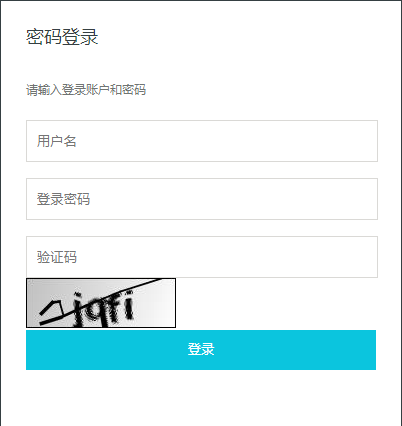在验证用户名和密码之前,引入辅助验证可有效防范暴力试错,图形验证码就是简单且行有效的一种辅助验证方式。下面将使用过滤器和自定义认证两种方式实现图形验证码功能。
验证码(CAPTCHA)的全称是Completely Automated Public Turing test to tell Computers and Humans Apart,翻译过来就是“全自动区分计算机和人类的图灵测试”。通俗地讲,验证码就是为了防止恶意用户暴力重试而设置的。不管是用户注册、用户登录,还是论坛发帖,如果不加以限制,一旦某些恶意用户利用计算机发起无限重试,就很容易使系统遭受破坏。

1.自定义过滤器
在Spring Security中,实现验证码校验的方式有很多种,最简单的方式就是自定义一个专门处理验证码逻辑的过滤器,将其添加到Spring Security过滤器链的合适位置。当匹配到登录请求时,立刻对验证码进行校验,成功则放行,失败则提前结束整个验证请求。
说到Spring Security的过滤器,我们先回顾一下前面使用过的配置。
@EnableWebSecurity
public class WebSecurityConfig extends WebSecurityConfigurerAdapter {
@Override
protected void configure(HttpSecurity http) throws Exception {
http.authorizeRequests()
.antMatchers("/admin/api/**").hasRole("ADMIN")
.antMatchers("/user/api/**").hasRole("USER")
.antMatchers("/app/api/**").permitAll()
.anyRequest().authenticated()
.and()
.csrf().disable()
.formLogin()
.and()
.sessionManagement()
.maximumSessions(1);
}
}
HttpSecurity实际上就是在配置Spring Security的过滤器链,诸如CSRF、CORS、表单登录等,每个配置器对应一个过滤器。我们可以通过 HttpSecurity配置过滤器的行为,甚至可以像CRSF一样直接关闭过滤器。例如,SessionManagement。
public SessionManagementConfigurer<HttpSecurity> sessionManagement() throws Exception {
return getOrApply(new SessionManagementConfigurer<>());
}
Spring Security通过SessionManagementConfigurer来配置SessionManagement的行为。与 SessionManagementConfigurer类似的配置器还有 CorsConfigurer、RememberMeConfigurer等,它们都实现了SecurityConfigurer的标准接口。
public interface SecurityConfigurer<O, B extends SecurityBuilder<O>> {
// 各个配置器初始化的方法
void init(B builder) throws Exception;
// 各个配置器被统一调用的方法
void configure(B builder) throws Exception;
}
SessionManagementConfigurer是在configure方法中将最终的SessionManagementFilter插入过滤器链来实现会话管理的,除Spring Security提供的过滤器外,我们还可以添加自己的过滤器以实现更多的安全功能,这些都可以在HttpSecurity中实现。
// 将自定义过滤器加在指定过滤器之后 public HttpSecurity addFilterAfter(Filter filter, Class<? extends Filter> afterFilter) { comparator.registerAfter(filter.getClass(), afterFilter); return addFilter(filter); }// 将自定义过滤器加在指定过滤器之前 public HttpSecurity addFilterBefore(Filter filter, Class<? extends Filter> beforeFilter) { comparator.registerBefore(filter.getClass(), beforeFilter); return addFilter(filter); }/** * 添加一个过滤器,但必须是Spring Security自身提供的过滤器实例或其继承过滤器 */ public HttpSecurity addFilter(Filter filter) { Class<? extends Filter> filterClass = filter.getClass(); if (!comparator.isRegistered(filterClass)) { throw new IllegalArgumentException( "The Filter class " + filterClass.getName() + " does not have a registered order and cannot be added without a specified order. Consider using addFilterBefore or addFilterAfter instead."); } this.filters.add(filter); return this; }// 添加一个自定义过滤器在指定过滤器位置 public HttpSecurity addFilterAt(Filter filter, Class<? extends Filter> atFilter) { this.comparator.registerAt(filter.getClass(), atFilter); return addFilter(filter); }
2.图形验证码过滤器
引入图形验证码API kaptcha,添加maven依赖
<dependency>
<groupId>com.github.penggle</groupId>
<artifactId>kaptcha</artifactId>
<version>2.3.2</version>
</dependency>配置一个kaptcha实例
/**
* 图形验证码配置类
*/
@Configuration
public class CaptchaConfig {
@Bean
public Producer captcha() {
// 配置图片验证码的基本参数
Properties properties = new Properties();
properties.setProperty("kaptcha.image.width", "150"); // 图片宽度
properties.setProperty("kaptcha.image.height", "50"); // 图片长度
properties.setProperty("kaptcha.textproducer.char.string", "0123456789qwertyuiopasdfghjklzxcvbnm"); // 字符集
properties.setProperty("kaptcha.textproducer.char.length", "4"); // 字符状态
Config config = new Config(properties);
// 使用默认的图形验证码实心,也可以自己实现
DefaultKaptcha defaultKaptcha = new DefaultKaptcha();
defaultKaptcha.setConfig(config);
return defaultKaptcha;
}
}
创建一个CaptchaController,用于获取图形验证码。
@Controller
public class CaptchaController {
@Autowired
private Producer producer;
@GetMapping("/captcha.jpg")
public void getCaptcha(HttpServletRequest request, HttpServletResponse response) throws IOException {
ServletOutputStream out = response.getOutputStream();
try {
response.setContentType("image/jpeg"); // 设置内容类型
String capText = producer.createText(); // 创建验证码文本
request.getSession().setAttribute("captcha", capText); // 将验证码文本设置到session
BufferedImage bufferedImage = producer.createImage(capText); // 创建验证码图片
ImageIO.write(bufferedImage, "jpg", out); // 推送响应流
out.flush();
}
finally {
if (out != null) {
out.close();
}
}
}
}当用户访问/captcha.jpg时,即可得到一张携带验证码的图片,验证码文本则被存放到session中,用于后续的校验。 有了图形验证码的API之后,就可以自定义验证码校验过滤器了。虽然Spring Security的过滤器链对过滤器没有特殊要求,只要继承了 Filter即可,但是在Spring体系中,推荐使用OncePerRequestFilter来实现,它可以确保一次请求只会通过一次该过滤器(Filter实际上并不能保证这一点)。
新建验证码校验失败异常类
public class VertifyCodeException extends AuthenticationException {
public VertifyCodeException() {
super("图形验证码校验失败");
}
}添加校验验证码的过滤器
/**
* 专门用于校验验证码的过滤器
*/
public class VertifyCodeFilter extends OncePerRequestFilter {
@Override
protected void doFilterInternal(HttpServletRequest request, HttpServletResponse response, FilterChain chain) throws ServletException, IOException {
// 非登录请求不校验验证码
if (!"/auth/form".equals(request.getRequestURI())) {
chain.doFilter(request, response);
}
else {
try {
vertifyCode(request);
chain.doFilter(request, response);
}
catch (VertifyCodeException e) {
e.printStackTrace();
}
}
}
/**
* 校验验证码是否正确
*
* @param request HttpServletRequest
* @throws VertifyCodeException VertifyCodeException
*/
private void vertifyCode(HttpServletRequest request) throws VertifyCodeException {
String code = request.getParameter("captcha");
String saveCode = (String) request.getAttribute("captcha");
HttpSession session = request.getSession();
if (!StringUtils.isEmpty(saveCode)) {
session.removeAttribute("cathcha");
}
if (StringUtils.isEmpty(code) || StringUtils.isEmpty(saveCode) || !code.equals(saveCode)) {
throw new VertifyCodeException();
}
}
}验证码仅仅核对session中保存的验证码与用户提交的验证码是否一致,逻辑并不复杂,只需将该过滤器添加到Spring Security的过滤器链中即可生效。
修改Spring Security配置类
@EnableWebSecurity
public class WebSecurityConfig extends WebSecurityConfigurerAdapter {
@Override
protected void configure(HttpSecurity http) throws Exception {
http.authorizeRequests()
.antMatchers("/admin/api/**").hasAuthority("ROLE_ADMIN")
.antMatchers("/user/api/**").hasRole("USER")
.antMatchers("app/api/**", "/captcha.jpg").permitAll() // 开放验证码的访问权限
.anyRequest().authenticated()
.and()
.csrf().disable()
.formLogin()
.loginPage("/myLogin.html")
.loginProcessingUrl("/auth/form").permitAll()
.failureHandler((request, response, e) -> {
// todo
});
// 将VertifyCodeFilter过滤器加在UsernamePasswordAuthenticationFilter过滤器之前
http.addFilterBefore(new VertifyCodeFilter(), UsernamePasswordAuthenticationFilter.class);
}
}修改自定义表单登录页
<!DOCTYPE html>
<html>
<head>
<meta charset="UTF-8">
<title>登录</title>
<link rel="stylesheet" type="text/css" href="css/login.css">
<style>
body{
background: #353f42;
}
*{
padding: 0;
margin: 0;
}
.main {
margin: 0 auto;
padding-left: 25px;
padding-right: 25px;
padding-top: 15px;
width: 350px;
height: 410px;
background: #FFFFFF;
/*以下css用于让登录表单垂直居中在界面,可删除*/
position: absolute;
top: 50%;
left: 50%;
margin-top: -175px;
margin-left: -175px;
}
.title {
width: 100%;
height: 40px;
line-height: 40px;
}
.title span {
font-size: 18px;
color: #353f42;
}
.title-msg {
width: 100%;
height: 64px;
line-height: 64px;
}
.title:hover{
cursor: default ;
}
.title-msg:hover{
cursor: default ;
}
.title-msg span {
font-size: 12px;
color: #707472;
}
.input-content {
width: 100%;
height: 200px;
}
.input-content input {
width: 330px;
height: 40px;
border: 1px solid #dad9d6;
background: #ffffff;
padding-left: 10px;
padding-right: 10px;
}
.enter-btn {
width: 350px;
height: 40px;
color: #fff;
background: #0bc5de;
line-height: 40px;
text-align: center;
border: 0px;
}
.foor{
width: 100%;
height: auto;
color: #9b9c98;
font-size: 12px;
margin-top: 20px;
}
.enter-btn:hover {
cursor:pointer;
background: #1db5c9;
}
.foor div:hover {
cursor:pointer;
color: #484847;
font-weight: 600;
}
.left{
float: left;
}
.right{
float: right;
}
</style>
</head>
<body>
<div class="main">
<div class="title">
<span>密码登录</span>
</div>
<div class="title-msg">
<span>请输入登录账户和密码</span>
</div>
<form class="login-form" action="/auth/form" method="post" novalidate>
<div class="input-content">
<div>
<input type="text" autocomplete="off" placeholder="用户名" name="username" required/>
</div>
<div style="margin-top: 16px">
<input type="password" autocomplete="off" placeholder="登录密码" name="password" required maxlength="32"/>
</div>
<div style="margin-top: 16px">
<div>
<input type="text" autocomplete="off" placeholder="验证码" name="captcha" required/>
</div>
<div>
<img src="/captcha.jpg" alt="验证码" width="150px" height="50px" />
</div>
</div>
</div>
<div style="text-align: center;margin-top:10px;">
<button type="submit" class="enter-btn" >登录</button>
</div>
</form>
</div>
</body>
</html>重启服务,访问任意一个受保护的资源即可看到带验证码的登录页面

当正确输入验证码时,可以正常访问对应资源。只要输入的验证码有误,就会返回一个401页面,至此,验证码登录功能就粗略实现了,而定制验证码的尺寸、验证码的失效属性、配置验证码的字符取值范围等,可以在此基础上集成。